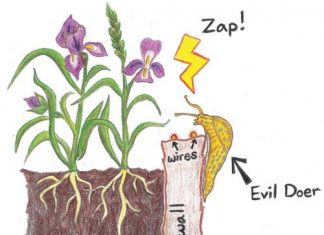 |
|
| Issue #103 • January/February, 2007 |
Hydrogen-fueled cars is a topic of much discussion these days. People who want to see the U.S. freed from dependence on foreign oil often assume the hydrogen-fuel automobile is just around the corner, if only big oil would get out of the way and an infrustructure of fueling stations built.
This article, of necessity, is somewhat technical, but it attempts to explain the current state of hydrogen fuel technology and dispel some of the pie-in-the-sky myths that surround it.
What is hydrogen?
Hydrogen is our lightest and most basic element and makes up more of the world than any other element. Unfortunately, it is almost always combined with other elements, so it must be separated back into its pure state for use as a fuel, and that takes lots of energy. For example, by now most of us recognize the chemical symbol H2O as a water molecule, made up of two hydrogen atoms bonded to one oxygen atom. I need to be careful here, as some of you teach chemistry and are not bashful about letting me know when I take too many liberties when discussing atoms, ions, and molecules in an attempt to keep things simple.
This means everyday river water can provide all of the hydrogen we will ever need to power our vehicles of the future. Unfortunately, I forgot to mention that it takes more energy to separate the hydrogen from the oxygen than the resulting hydrogen fuel can generate. This means hydrogen is not really a “fuel” at all. It is more like an energy “carrier,” to allow absorbing energy during its creation at the production facility for future use elsewhere, much like a rechargeable battery absorbs energy during charging, and then releases it later as power.
So where do we get it?
There are endless chemical processes that can release free hydrogen, but the three most common processes in use today for hydrogen production are water electrolysis, methane gas injected with steam, and liquid methanol electrolysis.
Water electrolysis is by far the simplest process and consists of two interconnected columns of water, each having an electrode wired to a battery or power source. Hydrogen is released into a gas at the negative (cathode) electrode, and oxygen is released in the water column containing the positive (anode) electrode. Again, since water’s chemical formula is H2O, only hydrogen and oxygen are produced when electrical energy is applied.
As long as we supply the power and keep refilling the tubes with water, we will keep making pure hydrogen and oxygen. However, the process requires almost 33 kWh of electricity to produce a gallon equivalent of hydrogen, which only becomes economical if we use waste energy from other industrial processes or off-peak utility power. For example, electric rates during the day are very high in most cities, but can be very inexpensive at night when demand is low. Using lower cost electric power during these night off-peak hours to generate hydrogen gas reduces the manufacturing cost, but you need to add even more electrical power to highly compress this gas or convert it to a cryogenic liquid for easier storage and transport.
Hydrogen gas has many industrial uses, and the most common manufacturing process is steam-injected methane gas. Although more complex than water electrolysis, this process can produce industrial-scale hydrogen at a lower cost than the electrolysis method. Unfortunately, this process also generates an almost equal quantity of carbon dioxide gas, which the world is trying desperately to reduce due to its greenhouse effect on the upper atmosphere.

The newest and most promising process to manufacture hydrogen gas was recently developed by NASA. This process is more complex, but it requires less than half the electrical power input as the water electrolysis process. This process uses liquid methanol, made from processed coal or corn, which is passed through a chamber divided by a thin membrane. Like the electrolysis of water process, electrodes of opposite polarity are located on each side of this membrane. Hydrogen ions easily pass through the special membrane and move toward the negative electrode, while leaving behind the waste carbon dioxide.
At the current demand for industrial hydrogen, the level of waste carbon dioxide generated is manageable; but any large scale conversion of the automobile industry from gasoline to hydrogen fuel-cell power would make our current world greenhouse gas-reduction efforts just a drop in the bucket. Again, remember hydrogen fuel does not exist naturally like coal, natural gas, or oil, and requires more energy input to make it than you can get back when used. Its only real advantages over fossil fuels are its zero emissions when producing power, and its ability to “store” energy for use later.
Hydrogen distribution
It takes more than 3.58 gallons of liquid hydrogen to provide the same energy contained in one gallon of gasoline. In addition, unlike gasoline, liquid hydrogen will remain a liquid only if contained in special cryogenic tanks to keep the liquid hydrogen at minus 423º F. Hydrogen can also be transported as a gas, but must be compressed to more than 2,400 psi to reduce its very light volume. This requires smaller diameter steel cylinders to withstand these high pressures, which means it cannot be transported in the large un-pressurized bulk gasoline tanks you pass every day on the interstate. Both of these factors lead me to believe it will take 8 to 10 times more tanker trucks, each carrying much smaller quantities of “fuel” per truck, to convey the same energy contained in the present gasoline distribution system.
Although some argue that a hydrogen-based automotive fuel distribution system will greatly increase the risk of explosions and fires, most of these issues can be minimized by utilizing better re-fueling procedures. Unfortunately, these procedures will most likely require a trained attendant, which will eliminate all self-serve gas pumps. For example, propane gas is regularly shipped in compressed liquid form to convenience stores and trailer parks, where portable propane gas tanks for grilles and recreational vehicles are quickly refilled using special threaded couplings by an attendant having a basic level of safety training.
Hydrogen gas is already routinely and safely transported by large trailer trucks to industrial customers all over the country. The only problem is these trucks use bundles of high-strength “tubes” instead of larger capacity bulk tanks due to the higher hydrogen storage pressures, so the significant increase in fuel-distribution tanker trucks already noted will be on our highways to transport the same amount of energy now contained in gasoline. This in turn will add even more to highway congestion, truck accidents, and road deterioration, not to mention the air-pollution from these many additional tanker trucks which, most likely, will still be diesel powered.
Hydrogen costs
One gallon of hydrogen gas compressed into a liquid weighs 0.59 pounds, and contains the “energy equivalent” of 0.279 gallons of gasoline. Although it’s not easy to compare hydrogen costs in terms of gasoline costs due to this difference in weights and energy equivalents, it takes about $4.33 of electricity to produce one gallon of hydrogen using the water electrolysis method. Since it takes 3.584 gallons of hydrogen to equal the energy contained in one gallon of gasoline, this means it would cost over $15.52 (3.584 gallon x $4.33), not to mention a fuel tank almost four times normal size, to contain the same energy content in a gallon of gasoline.
Since hydrogen fuel cells have a “net” energy efficiency of 66%, and a typical automobile engine has a “net” energy efficiency of 33%, using fuel cells instead of a gasoline engine to power a car means you could travel twice as far. This makes the equivalent cost around $7.76 per gallon ($15.52/2), but this is still almost three times the cost of gasoline at today’s prices.
Using hydrogen produced from steam injected methane would be less expensive than the water electrolysis costs described above, but gasoline would still need to cost over $5.83 per gallon before hydrogen fuel produced by this method would become economical.
By combining the gasification of cheap coal with the newer methanol electrolysis process, it is estimated this would be cost effective when gasoline reaches about $3.98 per gallon. However, there are still many cost unknowns related to building and operating a hydrogen distribution network and future restrictions on carbon dioxide emissions. These hydrogen manufacturing cost factors should be considered only a rough comparison to today’s gasoline costs, and will most likely increase due to other unforeseen and indirect distribution costs.
Hydrogen-fueled vehicles
Yes, you can modify a conventional gasoline engine to run on hydrogen gas using the same techniques as propane-fuel conversions. However, unlike propane which is a waste product of the gasoline manufacturing process, hydrogen is an end product requiring lots of high-cost energy to make, not to mention the major increase in carbon dioxide air-pollution produced during its manufacture. Both factors makes it very unlikely that many vehicle owners could justify this charge.
BMW in Munich has converted several 12-cylinder 5.4 liter high-end luxury sedans to hydrogen power. Unfortunately, their 140 mph top speed is of little use since there is only one hydrogen filling station in all of Europe.
Although there is an effort to convert other conventional vehicles to hydrogen by changing out the fuel systems, the most likely hydrogen-fueled vehicles in our future will be small-hybrid commuter models powered by fuel cells, not converted gasoline engines. A fuel cell is fairly small, lightweight, and has no moving parts.
When hydrogen gas is injected into a fuel cell, it produces lots of DC electric power, which is perfect to power an electric drive motor or recharge a battery pack. This is ideal for small, lightweight commuter vehicles in crowded cities since the only exhaust will be drops of water.
Summary
Unless I am really off-base, I think the economics and politics involved will dictate that the major demand for hydrogen-fueled vehicles will be in mega-cities that can no longer support the endless stream of carbon monoxide spewing commuters driving in-and-out each day. These cities may reach the point where the only individual commuter transportation allowed past outer-perimeter toll plazas or automated traffic control “barriers” will be hybrid electric or hydrogen fuel-cell powered.
The high social cost of inner-city air pollution may be able to justify building an infrastructure of hydrogen distribution and refueling facilities in and around these cities. However, I do not think we will see all gasoline and diesel powered trucks, SUVs, tractors, and farm equipment becoming obsolete any time soon, at least not in the rest of this vast open countryside.
I hate to point out the obvious, but there are other far less costly ways to reduce this automobile congestion and air pollution around large cities than trying to switch every vehicle to very energy inefficient hydrogen fuel. We still have a long way to go to make city mass-transit systems acceptable to the majority of commuters. How about a city where there are lots of trains, subways, and busses, that are actually clean and safe, that actually run on time and do not break down, that actually have routes that go where commuters want to travel, that are not so crowded you have to hang from a ceiling strap with a death-grip for an hour, that are not covered with spray-painted gang symbols, so most commuters will actually look forward to leaving their cars at home. No, I guess that’s far more difficult to accomplish than making our entire oil-based industries including oil refineries, engine manufacturers, oil tankers, gas stations, oil pipelines, and all gasoline-powered vehicles obsolete.
A special thanks to Mark Tomion with Archer Enterprises for his hydrogen-to-gasoline conversion factors (used by permission).
[weaver_widget_area id=’articles_about_yago’ class=’text3′]














